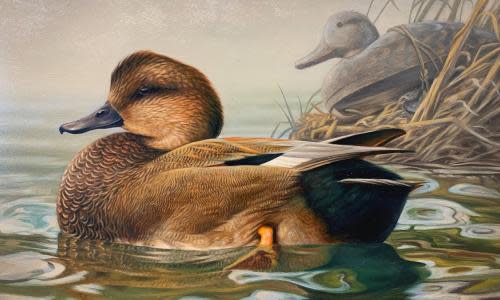'It should be about the duck': ire as new US nature stamps feature hunting gear

Each year, the country’s most talented wildlife artists submit their waterfowl-themed artwork to the US Fish and Wildlife Service’s (USFWS) annual contest to determine an image for the following year’s federal duck stamps. But this year’s entries look a little different.
In May, the USFWS announced a new, permanent theme for the stamps, which help fund wetland conservation: waterfowl hunting. That’s why this year’s submissions featured imagery of birds along with dispensed shotgun shells, duck calls lost among tall reeds, and hunters with rifles aimed at blue skies, as Audubon magazine first reported.
Artists, hunters and conservationists are voicing their concerns, including over whether the stamps promote the idea that conservation always involves hunting. The Trump administration has consistently sought to promote hunting, and to expand access to public lands for hunters as well as fossil fuel companies.
The focus on hunting has started “to divide people up: the hunting community versus the non-hunting community”, said Bill Hartwig, former chief of the National Wildlife Refuge System. “It focuses the attention back on the hunting community, when [it] should be a stamp purchased by every American.”
The submissions consistently feature lively, ornate illustrations of North America’s most beloved waterfowl species. This year, Audubon magazine estimated, at least 24 of 138 submitted artworks “featured either a duck call or shotgun shell in the water or strewn along its edge”.
Winning entries appear on stamps – formally known as the Federal Migratory Bird Hunting and Conservation Stamps – that raise around $40m yearly, and 98% of the money goes into acquiring and protecting wetlands for the National Wildlife Refuge System.
Yet the number of issued duck stamps has slowly tumbled – the USFWS sold nearly 200,000 fewer stamps between June 2017 and June 2018 than five years prior.
A USFWS spokesperson argued in an email that centering hunting was appropriate.
“The nation’s rich natural resources have been protected in perpetuity, largely because of hunters and their contributions through various revenue programs. The intent of the recent duck stamp regulation is to honor the history, culture, and conservation efforts founded by hunters and what they have provided to all Americans.”
Some artists feel sidelined by the decision. Last year, the USFWS requested the artists’ thoughts on the new rule. Most people opposed it, but the USFWS “railroaded it through”, said Richard Clifton, a wildlife artist and this year’s winner. His picture shows a single lesser scaup drake, and a lost duck call in the water beside it.
“I’m a pretty big-time waterfowl hunter, but I didn’t feel like [this rule] was necessary. Waterfowl hunters are going to buy the stamp regardless. [I’m not sure] why there’s a need to appease them,” said Clifton. “By mandating it, it puts a wrench into your design. Personally, I’d rather see the paintings be more about the duck.”
Rebekah Knight, a wildlife artist and Friends of the Migratory Bird/Duck Stamp board member, said that despite the agency’s intent to honor hunters, including hunter paraphernalia, in the artwork may be off-putting to those who don’t hunt. Lost duck calls and empty shells may be perceived as litter floating in the water, implying that “hunters are litterers”, she said.
“I really appreciate and want to celebrate hunters, [but] the potential artwork may paint a negative image of hunters, which is completely doing the opposite of what’s intended,” she said. “And if there’s a way to do that without placing such limitations on us artists, I would be all for it.”

 Yahoo Sport
Yahoo Sport 





































